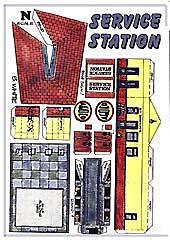
Petrol - Gasoline Service Station - Downloadable Card Model
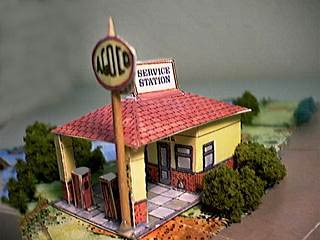
This one's shown in N scale and works well as a retro addition to your layout. It's styled after classic 'Service Stations' from a bygone era—how long since you've heard that term?
'AGOCO' on the sign stands for 'Arabian Goat's Milk and Oil Company,' tying into a whimsical historical hoax story (detailed below). Those hobby shop bushes add a nice touch! Designed by Brian White in Wiltshire, UK, who also created Foredown Tower for us.
What People Say
- "Brian White's design captures the 1930s essence perfectly—great for my N-scale diorama!" - Modeler from UK
- "The AGOCO tie-in adds fun history; built it in a weekend!" - FG Subscriber, USA
- "Excellent detail and easy assembly. Prompts me to learn more about vintage stations." - Hobby Enthusiast
More Pictures and Gallery
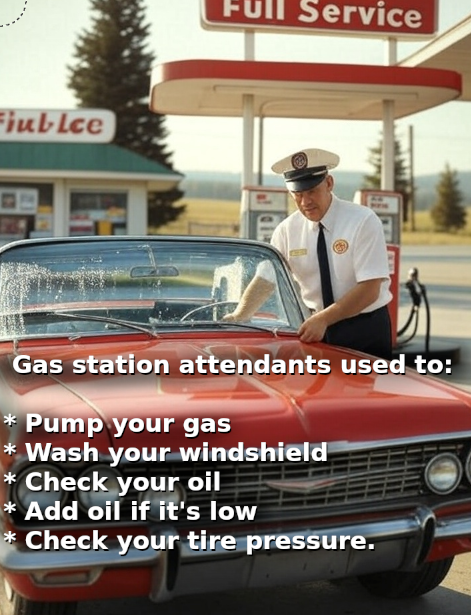
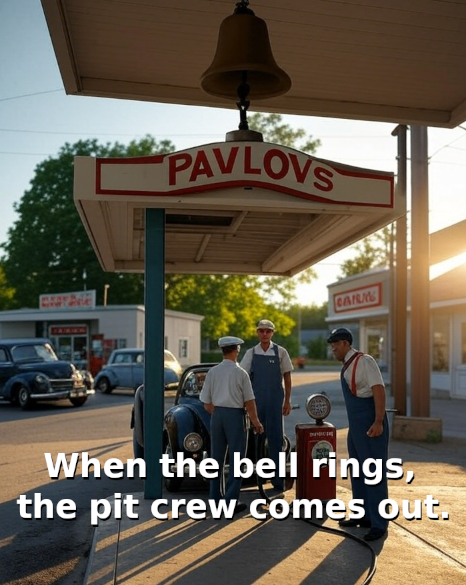

Service Station
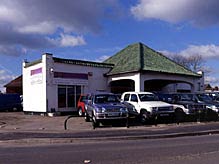 Newbury Electric Filling Station Newton Road, Newbury, Berkshire R. A. Wickens, 1934 Listed Grade II (More Below) |
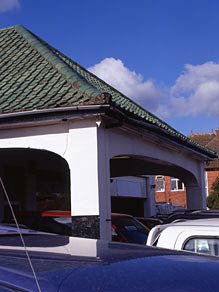 |
The Newbury Electric Filling Station opened in 1934 at the junction of Newton Road and Monks Lane, off a minor roundabout. It occupies a prominent site at a significant road junction. It is located in a primarily residential area on the south side of Newbury. When it was built the A34 was the main trunk road.
The service station was designed and built by R. A. Wickens, a local builder, for Mr Murray and Mr Whitaker who owned two other filling stations in the area at the time. The filling station was known locally as the "electric garage" because it featured the new electronically operated petrol pumping system rather than hand pumps. The filling station was advertised at the time as the most modern filling station in the district. At the time, a gallon of petrol cost 1s, 6d or 7 1/2p. Calladine & Morrison 1998 said it was 'The first building to clearly announce itself as a functional building self consciously devoted to the service of the automobile."
Newbury Electric Filling Station has been listed as a good example of the first generation of filling stations. It has survived in good condition and contributes to our understanding of petrol filling stations, a building type that has played an important role in the changing 20th century landscape. At the start of the 20th century petrol was sold in cans. With the growth of the automobile industry came the sale of petrol from roadside hand pumps. The combined effect of the 1927 Roadside Petrol Pumps Act and the Petroleum Act of the following year meant the appearance of new electric filling stations from where petrol was to be sold. The stations provided suitable covered areas for filling up vehicles and other amenities such as toilets. Later changes in transport needs, coupled with cars capable of carrying more fuel, led to more people filling up further from home. Although the building is in good condition it has been altered a lot. The electric pumps of the original building were removed eighteen years ago. The building is single story, brick construction and is covered in white render. It has a covered area at the front of the building supported by an arch that would have provided shelter to customers when filling up. The building still retains its unusual green glazed roof and original colored glass windows.
The property is being used as a car showroom by G & T Motors, with Philip Edghill as the current owner. A planning application of May 2003 proposed demolition of the existing garage and erection of twelve two-bedroom flats with associated parking and amenities. This planning application was subsequently removed by Mr Edghill, who wants to work with The Twentieth Century Society to retain the building and incorporate it into any subsequent development of the site. There are no current applications for demolition of this Grade II listed building. The local planning department believe that the proposed high-density housing is over- development and excessive especially with the lack of car parking in the area is taken into account. The proposed building would be unduly dominant on the site, and result in the demolition of a listed building contrary to adopted national and local plan policy. The application makes no reference to any pressing need for demolition other than the desire to re-develop the site. If planning permission is granted for development of the site it would be a good idea to retain the previously mentioned covered area at the front of the filling station and incorporate it into an entrance area or foyer for the new development. It would also be a good idea to incorporate the green glazed tiles into the housing, as these are a rare find in the area and of architectural significance. Thanks to Malcolm Palmer
Additional Historical Insights
The Newbury Electric Filling Station, opened in 1934 in Newbury, Berkshire, UK, was a pioneering roadside facility with electric pumps—a novelty over hand-cranked ones. Designed by local builder R.A. Wickens for owners Murray and Whitaker, it cost 1s 6d (7.5p) per gallon of petrol. As a Grade II listed building, it's preserved for its architectural significance as an early auto-service structure with brick, white render, and a green glazed roof. A 2003 demolition proposal for flats was withdrawn due to heritage policies, and it now houses G&T Motors as a car showroom.
This model reflects the 1930s boom in UK filling stations post-1927 Roadside Petrol Pumps Act, evolving from can sales to full-service stops.
Fun Trivia
- Early stations like this were called "electric garages" for their modern pumps, a far cry from today's self-serve.
- The whimsical "AGOCO" sign (Arabian Goat's Milk and Oil Company) adds humor, echoing creative branding of the era.
- Vintage stations often included amenities like toilets and shops, making them community hubs.
Model Building Tips
For N-scale accuracy, add tiny pump details using toothpicks and beads. Use metallic paints for the sign and arch to capture the 1930s shine. Integrate it into a diorama with period cars for a nostalgic scene, and consider LED lighting for the canopy.
The AGOCO Hoax: Chip Fyn in 1970s Pollock Pines
How the Arabian Goatmilk and Oil Company, and Ahib's Self Serve and Quick Mart, are still relevant today.
Nestled in the rugged embrace of the Sierra Nevada mountains, where the air carries the crisp scent of pine resin and the distant rumble of Highway 50 echoed like a perpetual whisper of adventure, Pollock Pines, California, in the summer of 1978 was a quintessential small-town haven. With a population hovering around a few thousand souls, it was the kind of place where everyone knew their neighbors, where the local 'Donut Corral' served up hearty breakfasts to loggers and tourists alike, and where the Pony Express Trail served as both a historic byway and the community's bustling main artery.
But beneath this idyllic facade simmered the lingering frustrations of a nation still reeling from the oil crises of the 1970s. The 1973 Arab oil embargo, sparked by geopolitical tensions over U.S. support for Israel during the Yom Kippur War, had sent shockwaves through America, quadrupling gas prices and introducing long lines at pumps, odd-even rationing days, and a pervasive sense of vulnerability. By 1978, prices in California had stabilized somewhat, averaging around 65 cents per gallon—a far cry from the pre-crisis days but still a burden for rural folks who relied on their trucks and cars for everything from commuting to hauling firewood.
In small towns like Pollock Pines, the impact was keenly felt: gas stations closed early, forcing late-night travelers to make the arduous hour-round-trip to 'Starvin Marvins' near Placerville, and anti-Arab sentiments festered like an unhealed wound, fueled by memories of empty tanks and economic hardship. It was against this backdrop of quiet resentment and everyday resilience that one of the most audacious and whimsical hoaxes in local history unfolded—a tale of satire, spectacle, and sly social commentary that would forever etch the name of Chip Fyn into the annals of eccentric Americana.
Chip Fyn, born under a different name but reborn as an artist through a series of fateful twists, was the heart and soul of the Sawdust Gallery on the historic Pony Express Trail right between the only two highway exits in the center of the community. His journey to this forested outpost had been anything but ordinary. In the early 1970s, while traversing the sun-baked roads of Tucson, Arizona, his bus erupted in flames, leaving him barefoot and destitute on the roadside. Miraculously, the only survivors from the inferno were his set of wood-carving chisels with their handles burned off. Perhaps a sign, he later quipped, from the universe itself to embrace that chapter of his life as a sculptor. When asked why he decided on Pollock Pines, he would simply point to the nearest among a multitude of enormous pine trees and ask, "Any more questions?" He was already a wood sculptor and couldn't say "sugar pine" without salivating.
Disillusioned with his prior life in aerospace engineering, where he designed helicopters for Sikorsky that morphed into tools of war during Vietnam, Chip headed west, drawn to Pollock Pines by its abundant natural resources and serene isolation. There, over several painstaking years, he hand-built the gallery from the remains of an old grocery store and adjacent barbershop using indigenous materials: sturdy river rock walls that seemed to rise organically from the earth, hand-hewn beams that whispered of old-growth forests, and hobbit-like sculptures that dotted the property like guardians from a fairy tale. A Bilbo Baggins figure propped up the porch roof, while inside, the centerpiece was a roaring furnace fashioned from a massive ore bucket salvaged from nearby mines, its smokestack a repurposed Vietnam-era napalm bomb, hollowed out and standing tall as a testament to Chip's knack for transforming the discarded into the delightful.
The gallery brimmed with his creations: intricate wood carvings of Keystone Kops and whimsical figures, stoneware "Mug Mugs" with comical faces that brought smiles to visitors, and interactive roadside attractions like "Happy the Hitchhiker," a nearly life-sized wooden sculpture thumbing for a ride, inviting passersby to pause and chuckle amid their journeys. An inscription on the back of the carving invited travellers to carry him along on his trek across the country to his father's home in Monroe, Connecticut. An entire wall in the Gallery was dedicated to newspaper clippings Happy had collected on his adventures, sometimes aided and occasionally lost for a spell, but always resurfacing to continue his adventures. He made appearances overseas, from an exhibit in Yugoslavia on 'American Kinetic Art' to a distant family home in the 'Land Down Under'.
Chip's partner in mischief was Steve Mizera, a man whose own life story read like a novel of perseverance and reinvention. Born in 1940 in Cressona, Pennsylvania, Steve had endured a childhood marked by orphanages and hardship before serving in the U.S. Air Force and working as a railroad conductor. By the late 1970s, he had settled in Pollock Pines with his partner Judith Nelson, where they founded the Pollock Pines Press - a modest but influential local newspaper that captured the pulse of the community for several years. Steve's background in journalism and his sharp wit made him the perfect collaborator for Chip's schemes. Their evenings on "Cookie Hill" (a nearby property Chip owned a few stone's throws away) was often filled with sweet wine and brainstorming sessions that blurred the lines between art, activism, and amusement. Together, they hatched a plan that would leverage the Press's reach and the gallery's visibility to poke fun at the oil crises, creating AGOCO—the Arabian Goat's Milk and Oil Company—a fictional entity blending absurdity with pointed satire on corporate greed and energy woes.
The hoax began subtly in late spring, as the last snowdrifts melted into rivulets along the roadside and wildflowers began to dot the landscape. One crisp morning, Chip entered the gallery's workshop, where his 15-year-old son was dutifully cranking an antique air blower to stoke the furnace's flames, the wood chips and wood carving scraps crackling and popping like distant fireworks. Without a word, Chip grabbed sheets of weathered plywood and began nailing them over the large front windows, shrouding the gallery's inviting facade in mystery. To the locals driving by on Pony Express Trail, retirees on their way to fishing holes and families en route to camping spots, the sight was baffling. Whispers spread like wildfire through the diners and general stores: Was the Sawdust Gallery closing? Have economic pressures finally caught up to the quirky artist?
Weeks passed, and the intrigue deepened. A simple "For Sale" sign appeared in front of the property, its stark hand painted red letters against a white background standing out like a sore thumb amid the greenery. The community, already fond of Chip's eccentricities, began to mourn. "Losing Chip Fyn would be like losing the soul of Pollock Pines," one resident lamented over an early coffee at the Donut Corral, noting how the gallery had become a must-stop for tourists and visiting family members seeking unique souvenirs like those grinning Mug Mugs or carved wooden Indians. Then, as if to twist the knife, the sign changed to "Sold," plunging the town into a collective sigh of regret. Questions buzzed at schoolyards, the bank, barbershops, and especially the bars: Where would Chip go? What would become of the whimsical haven that made their little town on the map something more original and different?
But Chip and Steve were just warming up. Soon, a vibrant, eye-catching placard replaced the sold sign, boldly proclaiming "Coming Soon! Ahib's Self Serve and Quick Mart." Rumors ignited overnight. The property seemed to have been snapped up by Arab investors intent on building a gas station right there on Pony Express Trail. In a community with no Arab residents, this news landed like a bombshell, rekindling the anti-Arab sentiments that had simmered since the embargo's gas lines and shortages. Chip, once celebrated as a local legend, was suddenly whispered about as a traitor for "selling out." Heated discussions erupted in living rooms and at the post office, with some folks decrying it as an invasion, a bold insult to American resilience. Chip's son, fielding queries from classmates and neighbors, could only shrug and say truthfully that he didn't know - even though suspicions were beginning to brew at home as his stepmother, Tona, a soft-spoken woman from Colombia, quietly sewed elaborate Arab costumes under a veil of secrecy. She wouldn't tell him why, but something was definitely afoot.
As the plot thickened, the Pollock Pines Press under Steve's editorial hand became the maestro of manipulation. A front-page story announced that the new station would operate 24 hours a day, seven days a week. In a town where existing pumps locked up at 6 p.m. sharp, this was revolutionary. No more midnight treks to Starvin' Marvin's for fuel. Convenience was on the horizon. Public opinion swung like a pendulum: Support surged among the pragmatic, pitting them against the holdouts and extremists who clung to their prejudices. Debates raged at Chamber of Commerce meetings, which Chip notably skipped despite being an active member, fueling further speculation. Rumors even circulated that meeting minutes had mysteriously vanished, adding a layer of conspiracy to the air.
Then came the masterstroke. The Press dropped a bombshell article: Yes, gas would be available around the clock at Ahib's Self Serve and Quick Mart, 24/7, but at a jaw-dropping $2.00 per gallon, nearly triple the local average. Outrage boiled over. Pre-emptive boycotts were organized, petitions circulated, and the town unified in indignation against this perceived gouging. The best plan, everyone agreed, was to protest the installation of the required fuel tanks on environmental grounds, and put it to a vote.
The El Dorado County inspector, a stern figure in official attire, arrived unannounced, demanding to see permits for the underground gas tanks that, of course, didn't exist. Chip, playing the part of the befuddled former owner, handed over a phony business card for AGOCO, complete with scribbled Arabic script that no one in town could decipher. The inspector left scratching his head. The encounter became fodder for the tale, but never made it into the headlines and barroom rumors.
Behind the scenes, the preparations were a whirlwind of creativity and covert operations. Fliers and promotional pencils, emblazoned with Ahib's logos, were distributed far and wide along Highway 50, from the valley floors of Placerville to the alpine heights of Lake Tahoe. Every place that you could get the Pollock Pines Press, you could also get free pencils announcing the Grand Opening of Ahib's Self Serve and Quick Mart, and you could read about the unfolding story and discuss it with the proprietor or other customers. This was well before the internet when news spread in mysterious ways.
As concern heightened, Chip enlisted his son and Steve for cryptic appearances. Dressed in flowing robes, dark sunglasses, and headscarves, they slipped into local bars for quick, silent drinks, vanishing before anyone could engage them. These sightings amplified the hysteria, turning whispers into shouts.
As July 4th approached, the climax loomed. In the dead of night on July 3rd, under a canopy of stars and the hush of the forest, Chip and his accomplices worked feverishly. The plywood boards came down from the windows, revealing the gallery untouched. Overnight, a faux gas station sprang to life: Wooden pumps meticulously created by Chip's own hands, painted in garish colors; a life-sized Arab figure, whittled from pine, clutching a pretend hose as if ready to dispense fuel; a large sign on a nearby tree offering "Free Water and Air," flanked by an old fire bucket for water and a rusty, broken bicycle pump for air. Banners and streamers fluttered in the breeze, hundreds of colorful balloons bobbed like festive sentinels, and the entire setup screamed "Grand Opening" in bold, mocking letters.
Along Pony Express Trail, a series of Burma Shave style signs - those classic sequential roadside rhymes from a bygone era - delivered the satirical punches. Though the exact jingles have faded into legend, they reportedly built upon one another with witty barbs about oil barons, inflated prices, and consumer woes, culminating in a cheeky line about how folks could expect to be "screwed" at the pump. The costs of this elaborate production - materials, printing, balloons, advertising - were cleverly offset by Chip's plan to repurpose the props as collectible art pieces, sold to admirers of the stunt.
The reveal unfolded amid the pomp of Pollock Pines' annual Independence Day Parade, a cherished tradition that dates back decades and continues to this day, organized by the local Rotary Club. On that sunny July 4th, as fire trucks blared their sirens, dancers twirled in patriotic garb, and floats rolled down Pony Express Trail toward the Service Center, the procession passed right by the gallery. Crowds gathered, gawking at the absurd setup, the costumed figures waving merrily, and the signs' pointed humor. The Press's special edition laid it bare: It was all a hoax, AGOCO a fictional jab at the oil crises, blending the ridiculous notion of goat's milk as fuel with a critique of petroleum profiteering. Laughter erupted among many, though a few grumbled at the deception, their opinions flipped one final time from fury to amusement.
In the aftermath, the stunt catapulted the Sawdust Gallery to new heights of fame, drawing even more visitors eager for a piece of the legend. The expenses were recouped through art sales, but not without a final twist: A lawsuit accused El Dorado County of removing and destroying some of the roadside signs, leading to an out-of-court settlement for an undisclosed sum - a quiet victory for Chip's brand of creative rebellion.
Today, as the parade still marches each July 4th and Highway 50 hums with modern travelers, Chip Fyn's AGOCO hoax stands as a timeless reminder of how art and satire can challenge the status quo. His legacy, carried on through memorials, fan groups, and his later innovations like the Fiddlers Green website for paper models, inspires those who dare to blend whimsy with wisdom. In an era of media manipulation and echo chambers, the story of AGOCO whispers a cautionary yet joyful tale: Sometimes, the best way to confront absurdity is with a hearty dose of your own.
Recently released to FG subscribers - Join now for three free models, the AGOCO story, and more exclusives!


